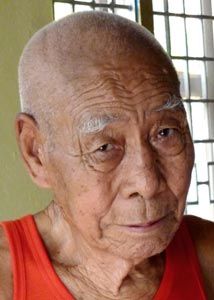Name: Anzi
(Alias: No)
Gender: Male
Interview Age: 83
Date of Birth: 1927
Birthplace: Motho, Kham, Tibet
Year Left Tibet: 1959
Profession: Monk
Monk/Nun: Currently
Political Prisoner: No

Interview No.: 10M
Date: 2010-04-06
Language: Tibetan
Location: Doeguling Settlement, Mundgod, Karnataka, India
Categories: Resistance and Revolution
Keywords: business practices/livelihood, childhood memories, Chinese -- oppression under, Chushi Gangdrug guerrillas, Dalai Lama -- escape, Kham, March 10th Uprising, monastic life, refugee in India -- life as
Summary:
As a child, Anzi led a happy life playing with his friends and occasionally helping his family in herding their animals. In his teens he made the decision to become a monk as did many of the village boys. At the age of 18, he left for Lhasa to join Gaden Monastery near Lhasa. He talks about his long journey from his village to Lhasa to the monastery.
Anzi explains how people from far away regions who came to join the three great monasteries of Sera, Drepung and Gaden were specifically assigned to one of the monastery's khangtsen 'houses' based on their place of birth. He describes the holder of the throne of Gaden, the highest position in the Gelugpa sect of Tibetan Buddhism. Anzi gives a detailed account of his life as a grain collector for his monastery. The grains were loaned to people of the villages and collected along with an interest at the time of harvest.
After the Chinese invasion, Anzi voluntarily joined the Chushi Gangdrug [Defend Tibet Volunteer Force] to fight against the Chinese forces. Anzi gave up his monks' vows in order join the Force because he believed strongly in defending the Dalai Lama and his country. He and many other monks from Gaden collected guns from the Potala Palace and witnessed the turmoil in Lhasa at that time, including a protest by the Tibetan Women's Association.
Interview Team:
- Marcella Adamski (Interviewer)
- Tenzin Yangchen (Interpreter)
- Pema Tashi (Videographer)

